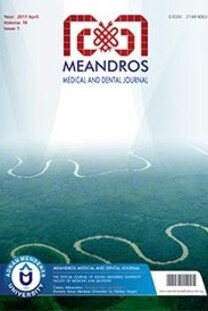Enflamatuvar Meme Kanserinde Moleküler Alt Tip Dağılımı ve Siklooksijenaz-2 Ekspresyon Durumu
Enflamatuvar meme kanseri, moleküler alt tip, siklooksijenaz-2
Molecular Subtype Distribution and Cyclooxygenase-2 Expression Situation in Inflammatory Breast Cancer
Inflammatory breast cancer, molecular subtype, cyclooxygenase-2,
___
- 1. Lee BJ, Tannenbaum EN. Inflammatory carcinoma of the breast. Surg Gynecol Obstet 1924; 39: 580-95.
- 2. Hance KW, Anderson WF, Devesa SS, Young HA, Levine PH. Trends in inflammatory breast carcinoma incidence and survival: the surveillance, epidemiology, and end results program at the National Cancer Institute. J Natl Cancer Inst 2005; 97: 966-75.
- 3. Anderson WF, Schairer C, Chen BE, Hance KW, Levine PH. Epidemiology of inflammatory breast cancer (IBC). Breast Dis 2006; 22: 9-23.
- 4. Kerlikowske K, Molinaro AM, Gauthier ML, Berman HK, Waldman F, Bennington J, et al. Biomarker expression and risk of subsequent tumors after initial ductal carcinoma in situ diagnosis. J Natl Cancer Inst 2010; 102: 627-37.
- 5. Van Laere SJ, Van den Eynden GG, Van der Auwera I, Vandenberghe M, van Dam P, Van Marck EA, et al. Identification of cell-of-origin breast tumor subtypes in inflammatory breast cancer by gene expression profiling. Breast Cancer Res Treat 2006; 95: 243-55.
- 6. Kertmen N, Babacan T, Keskin O, Solak M, Sarici F, Akin S, et al. Molecular subtypes in patients with inflammatory breast cancer; a single center experience. J BUON 2015; 20: 35-9.
- 7. Denkert C, Winzer KJ, Müller BM, Weichert W, Pest S, Köbel M, et al. Elevated expression of cyclooxygenase-2 is a negative prognostic factor for disease-free survival and overall survival in patients with breast carcinoma. Cancer 2003; 97: 2978-87.
- 8. Half E, Tang XM, Gwyn K, Sahin A, Wathen K, Sinicrope FA. Cyclooxygenase-2 expression in human breast cancers and adjacent ductal carcinoma in situ. Cancer Res 2002; 62: 1676-81.
- 9. Glover JA, Hughes CM, Cantwell MM, Murray LJ. A systematic review to establish the frequency of cyclooxygenase-2 expression in normal breast epithelium, ductal carcinoma in situ, microinvasive carcinoma of the breast and invasive breast cancer. Br J Cancer 2011; 105: 13-7.
- 10. Friedman GD, Ury HK. Initial screening for carcinogenicity of commonly used drugs. J Natl Cancer Inst 1980; 65: 723-33.
- 11. Ashok V, Dash C, Rohan TE, Sprafka JM, Terry PD. Selective cyclooxygenase-2 (COX-2) inhibitors and breast cancer risk. Breast 2011; 20: 66-70.
- 12. Subbaramaiah K, Hart JC, Norton L, Dannenberg AJ. Microtubule-interfering agents stimulate the transcription of cyclooxygenase-2. Evidence for involvement of ERK1/2 AND p38 mitogen-activated protein kinase pathways. J Biol Chem 2000; 275: 14838-45.
- 13. Falandry C, Canney PA, Freyer G, Dirix LY. Role of combination therapy with aromatase and cyclooxygenase-2 inhibitors in patients with metastatic breast cancer. Ann Oncol 2009; 20: 615- 20.
- 14. Arun B, Goss P. The role of COX-2 inhibition in breast cancer treatment and prevention. Semin Oncol 2004; 31(2 Suppl 7): 22- 9.
- ISSN: 2149-9063
- Yayın Aralığı: 4
- Başlangıç: 2000
- Yayıncı: Aydın Adnan Menderes Üniversitesi
Sunumu Ovarian Strumal Karsinoid: Olgu
Betül Bolat KÜÇÜKZEYBEK, Ayşe VATANSEVER, Aylin Orgen ÇALLI, Türkan REZANKO
Mutlu ÇOBANOĞLU, Özgür ÖZBEY, Öner ŞAVK, Ferit ÖZGEZMEZ
Enflamatuvar Meme Kanserinde Moleküler Alt Tip Dağılımı ve Siklooksijenaz-2 Ekspresyon Durumu
Püsem PATIR, Burçak Karaca, Alper Şener, Osman ZEKİOĞLU, Güray SAYDAM, Canfeza Sezgin
Ahmet YANARATEŞ, Filiz HATİPOĞLU, Ayşegül AKGÜN, Kamil KUMANLIOĞLU
